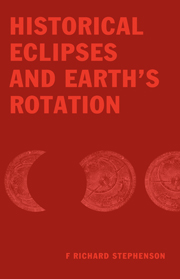Book contents
- Frontmatter
- Contents
- Principal Symbols
- 1 Variations in the length of the day: a historical perspective
- 2 Tidal friction and the ephemerides of the Sun and Moon
- 3 Pre-telescopic eclipse observations and their analysis
- 4 Babylonian and Assyrian records of eclipses
- 5 Investigation of Babylonian observations of solar eclipses
- 6 Timed Babylonian lunar eclipses
- 7 Untimed Babylonian observations of lunar eclipses: horizon phenomena
- 8 Chinese and other East Asian observations of large solar eclipses
- 9 Other East Asian observations of solar and lunar eclipses
- 10 Records of eclipses in ancient European history
- 11 Eclipse records from medieval Europe
- 12 Solar and lunar eclipses recorded in medieval Arab chronicles
- 13 Observations of eclipses by medieval Arab astronomers
- 14 Determination of changes in the length of the day
- Appendix A Timed data
- Appendix B Untimed data
- References
- Acknowledgements
- Index of eclipse records
- Index of places of observation
- Name Index
- Subject index
6 - Timed Babylonian lunar eclipses
Published online by Cambridge University Press: 13 November 2009
- Frontmatter
- Contents
- Principal Symbols
- 1 Variations in the length of the day: a historical perspective
- 2 Tidal friction and the ephemerides of the Sun and Moon
- 3 Pre-telescopic eclipse observations and their analysis
- 4 Babylonian and Assyrian records of eclipses
- 5 Investigation of Babylonian observations of solar eclipses
- 6 Timed Babylonian lunar eclipses
- 7 Untimed Babylonian observations of lunar eclipses: horizon phenomena
- 8 Chinese and other East Asian observations of large solar eclipses
- 9 Other East Asian observations of solar and lunar eclipses
- 10 Records of eclipses in ancient European history
- 11 Eclipse records from medieval Europe
- 12 Solar and lunar eclipses recorded in medieval Arab chronicles
- 13 Observations of eclipses by medieval Arab astronomers
- 14 Determination of changes in the length of the day
- Appendix A Timed data
- Appendix B Untimed data
- References
- Acknowledgements
- Index of eclipse records
- Index of places of observation
- Name Index
- Subject index
Summary
Introduction
Because so many observations of lunar eclipses are preserved on the Late Babylonian astronomical texts, it is necessary to devote two chapters of this book to their discussion. This is a reflection of the great importance of the lunar eclipse records from Babylon in the study of long-term changes in the length of the day. The present chapter is restricted to timed contacts, while in chapter 7 a variety of untimed observations of eclipses of the Moon will be considered.
Most Babylonian lunar eclipse timings are expressed relative to sunrise or sunset, although very occasionally they are referred to moonrise or moonset instead. I have divided these measurements into four categories: (i) those for which only a single contact timing is preserved; (ii) timings of two separate contacts (mainly partial eclipses); (iii) three or four contact timings (total eclipses only); and (iv) timings of eclipse maxima (partial eclipses only). Observations in these categories will be discussed in turn in sections 6.2 through 6.5. In addition, a number of eclipses were also timed in relation to the culmination of certain reference stars (see section 6.6).
Times of the very earliest eclipses (whether observed or predicted) were nearly always quoted with low precision. Between 731 BC (the earliest surviving record, representing a prediction) and just before 600 BC times were almost exclusively expressed to the nearest 10 deg.
- Type
- Chapter
- Information
- Historical Eclipses and Earth's Rotation , pp. 147 - 192Publisher: Cambridge University PressPrint publication year: 1997



